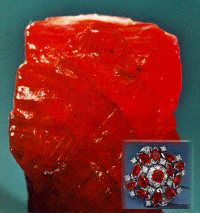Samson
Jewellery - Birth Stone
July / Ruby

In India ruby, known as the king of precious stones, was supposed to preserve health; like other red stones it was associated with blood. It was said to protect the wearer from wounds and cure haemorrhaging. Ruby was associated with love, too, and was credited with controlling the passions. Rubies are much rarer than saphires and large specimens are seldom found. A ruby of over 5 carats is exceptional.
Mining. The chief source of rubies in the Ancient World was the Mogok Stone Tract, an area of 400 square miles in Upper Burma. The great age of these mines is proved by the fact that both Stone Age and Bronze Age tools have been found on the site. The stones found here ware originally formed in limestone rocks, but these rocks weathered away over a period of time in the distant past and turned to gravel and sand in which rubies were first found thousands of years ago. Like so many places where gemstones are found, the Mogok region is remote and unhealthy and over a long period the kings of Burma, for lack of voluntary miners, sent capive slaves to work there. In 1886 the area was annexed by Britain and a company was formed to undertake mining. Since Independence mining has been sporadic and supplies from th earea very much restricted; now the mines have been closed altogether. So Burma ruby, for a long time a rare stone, is likely to be rarer than ever in the future.
Fortunately other sources of ruby still exist. Thailand has over the years been the next most important source. Here family groups sink shallow mines into the clay to reach the gem-bearing alluvial beds in the province of Chantabun. The rubies they find are of a brownish colour and many of them are raher dark. The discovery by an American geologist of rich ruby deposits in Kenya in 1975 caused considerable excitement in the gem trade, because of the good colour of the stones, but in the event only a small number of stones proved suitable for faceting. These Kenya rubies are, however, going to fill the gap created by the closing down of the Burma mines and happily Kenya is one African country which still allows gems to be freely exported. Star rubies, like star sapphires, can be most attractive if they are of good colour.
Fakes and imitation. A number of other natural stones can be mistaken for ruby. Red spinels, garnets and red tourmalines can masquerade as rubies, but a jeweller could identify these by simple tests which would be carried out in the normal course of valuation of the stones. As with sapphires, beware of doublets.
¡@